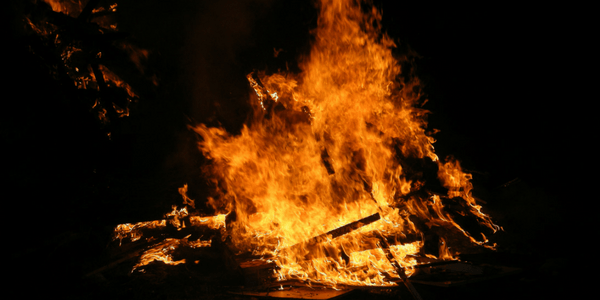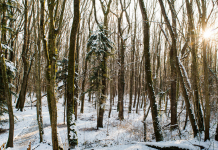 Imbolc is one of the greater sabbats, celebrated as the halfway point towards spring, and lands, yearly, on February first or second. Though not as well-known outside of Pagan communities as Samhain and Beltane, this festival breaks up the winter season and helps point us towards preparing the fresh beginnings of spring.
Imbolc is one of the greater sabbats, celebrated as the halfway point towards spring, and lands, yearly, on February first or second. Though not as well-known outside of Pagan communities as Samhain and Beltane, this festival breaks up the winter season and helps point us towards preparing the fresh beginnings of spring.
Imbolc is also known as Candlemas and the feast of lights.1 It is not necessarily a celebration of spring, but instead its focus is on getting ready for spring. It is a celebration of life and light beginning their return to the land, but not a full blown welcome ceremony. Much of the tradition surrounding this festival is in praise to the goddess Brigid, but even if you do not follow a traditional Celtic or Wiccan path, this celebration can be easily adapted for a number of belief systems.
Breaking the celebration down to its basic elements makes space for adaptations to the individual paths that we walk.
What is Imbolc
On February first, we will hit the half way point between Samhain and Beltane, and celebrate this occasion with Imbolc. This festival feels like spring, but it is important to remember that it is not spring. This celebration is about the coming of spring and preparing for the renewal of the world.
To that end, the symbols that surround this celebration have a lot to do with fertility and things that are coming into being. If Samhain is the end of things, then Imbolc would be the beginning of them. This sabbat is about preparing the world for the coming planting; physically, mentally, and spiritually.
Traditional imagery seen during this time include a number of references to the goddess Brigid,2 fertility, flames, candles, fire, along with the colour white.
As I mentioned, you don’t have to find an instant resonance with Imbolc’s symbols to know and work with its magick. But if we start with thinking through the meaning of the symbols, from there we can adapt our own new traditions.

Fire and white candles everywhere
The first symbol I’ll be dealing with is perhaps the most visible, the humble candle. Imbolc is a feast day devoted, in part, to fire and its life-giving properties. There are many rites and rituals based around the traditional hearth, including using the ashes from the fire in ritual and making a place for the goddess in front of it. Most modern homes don’t really have hearths, so many of the traditional flame rituals are no more. However, white candles are easy to find, and a great solution if you can’t work with a heartier source of fire.
Part of the celebration that occurs at Imbolc is for the coming return of the light (literally, the sun). Although we’re still in winter, we still can honour that life-giving power of heat and illumination, and for many of us, we can feel the sunshine’s subtle and slow return. If you have an altar, adding white candles to honour the season and giving thanks on this day is a simple way to celebrate the sabbat.
If you do not have an altar, setting up a small display with candles and meditating on what you want to achieve for the coming year, or season is a small ritual to perform around Imbolc, if you follow an eclectic path.
In addition, this is the perfect time to do candle magick workings3. Although many spells call for specific candle colours (for example, green is often suggested for money spells and red for love), most texts will tell you that it is fine to substitute plain white candles. The important thing is your intent. General protection spells and those focused on aspects of the home or growth would be best for this day.
The Divine Feminine
Many of the traditional Wiccan and Celtic practices were focused on the specific goddess of Brigid and entering into her season. Obviously not everyone follows this particular goddess or path, but it is still worthwhile to honour the Divine Feminine at Imbolc.
The Divine Feminine is represented across a multitude of different paths by different ideas, names, and images. For some, the divine is a literal goddess (or many). Imbolc is a perfect time to honour these goddesses. If you have an altar set up for them, it would be appropriate to make offerings of their favourite foods, or seeds for their favourite flowers to honour the coming planting season. You can pledge to plant these seeds and care for them when the weather is appropriate as a way to thank them for their favour and support.
If you do not follow a specific goddess or a path where one is present, this time of year is also appropriate to honour the aspects of the Divine Feminine in nature. Place your feet or hands on the bare earth (if it’s not too bitterly cold) for a few moments and give thanks.

Fertility is more than babies
Fertility is usually associated with babies and things that grow; new life, as it were. And although this is certainly important, it is not the only way we can represent fertility in our lives. Fertility also appears whenever there is growth in our lives, and can be honoured in other ways, including doing magick for business and new ventures, or personal growth.
Before we jump into that that, however, let’s just put the traditional out there. Much of the common traditional rituals associated with this feast day are not so thinly veiled metaphors for sex. The making of a brideog by men ((ADF, “Author Information.”)) — a small simple doll, usually made from straw and dressed in white — mirrors the making of a baby, while the making of brid’s bed by women brings up images of impregnation and the “marriage bed.” This feast very clearly deals with sexual fertility, and it is appropriate to honour that part of our lives during this season, of course, if that’s your thing.
But now is also time to put energy into new things and put power and intent towards their growth. Focusing your energy on things that you want to see come to fruition in positive ways is a strong way to celebrate Imbolc. New businesses, new homes, or simply new healthy habits are things that hail back to this idea of fertility. Of making a place where something, in this case you, can flourish and grow.
A simple ritual to do related to this idea would be to take a white stone or crystal such as selenite, clear fluorite, or even a milky quartz and hold it in your hand. In all honesty, it can be a white stone you picked up from outside. This might seem a strange choice, as nothing grows in stones, but it is a symbolic representation of the earth, and thus, fertility. Focus your intentions for the coming year, and “implant” them into the stone as you would plant a seed in the earth. Once you are satisfied, place the stone in a small bag or cloth and keep it near you to imbue with your energy and strength, as you would nurture a child. As the year passes, you will see your intent grow.
If you are specifically focusing on money or business, a cowrie shell can be substituted. Cowrie shells have historically been used as currency4 and their colouration makes them suitable replacement for a stone at this holiday. Different paths may have more of an affinity for this symbol.
Hearth really just means home
There are a lot of rituals that refer to the hearth but really, that’s just another word for home in the modern age. Imbolc can be a celebration of home and family. Some rituals suggest cleaning and smudging your home, and really, the idea of spring cleaning owes a lot to this feast day.
Taking a bit of time to revive the energies in your home, clean up your altar space, and dispel negative energy will go a long way in the coming year.
If you have family in your life (family you choose counts here and everywhere!) now would be a perfect time to gather around and talk about the positive things that everyone is looking forward to in the coming year. Susan Starr wrote an excellent piece that offered some suggestions for yummy Imbolc meals, and if those aren’t to your tastes, think of communal foods that can be made in a single pot and shared. A really low-key ritual here would be to have everyone bring an ingredient for a dish, and to bless all that helped and dined.
Making Imbolc your own
These are just some suggestions for how you can make this feast day fit your practice. Though traditional celebrations may seem very stiff, this just isn’t the case, and there are likely many more ways that non-traditional practitioners can take this feast day and make it their own. This is a really warm celebration for honouring many things but most of all, it’s a celebration of life, joy, and the coming of good things. And who doesn’t want more of that in their lives?
Image credits: webhamste, distelfliege, Vasile Cotovanu
- Northernway, “Feb. 2 Christo-Pagan Holiday Candlemas, Imbolc, Oimelc, Groundhog Day.” [↩]
- Druidry.org, “Brigid: Survival of A Goddess.” [↩]
- Brujonegrobrugeria.com, “Candle Magic.” [↩]
- nbbmuseum.be, “Cowry Shells, a Trade Currency.” [↩]








